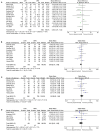Laparoscopic vs. Open Pancreaticoduodenectomy After Learning Curve: A Systematic Review and Meta-Analysis of Single-Center Studies
- PMID: 34568416
- PMCID: PMC8461253
- DOI: 10.3389/fsurg.2021.715083
Laparoscopic vs. Open Pancreaticoduodenectomy After Learning Curve: A Systematic Review and Meta-Analysis of Single-Center Studies
Retraction in
-
Retraction: Laparoscopic vs. open pancreaticoduodenectomy after learning curve: A systematic review and meta-analysis of single-center studies.Front Surg. 2022 Jul 26;9:988654. doi: 10.3389/fsurg.2022.988654. eCollection 2022. Front Surg. 2022. PMID: 35959123 Free PMC article. Review. No abstract available.
Abstract
Background: Although laparoscopic pancreaticoduodenectomy (LPD) is a safe and feasible treatment compared with open pancreaticoduodenectomy (OPD), surgeons need a relatively long training time to become technically proficient in this complex procedure. In addition, the incidence of complications and mortality of LPD will be significantly higher than that of OPD in the initial stage. This meta-analysis aimed to compare the safety and overall effect of LPD to OPD after learning curve based on eligible large-scale retrospective cohorts and randomized controlled trials (RCTs), especially the difference in the perioperative and short-term oncological outcomes. Methods: PubMed, Web of Science, EMBASE, Cochrane Central Register, and ClinicalTrials.gov databases were searched based on a defined search strategy to identify eligible studies before March 2021. Only clinical studies reporting more than 40 cases for LPD were included. Data on operative times, blood loss, and 90-day mortality, reoperation, length of hospital stay (LOS), overall morbidity, Clavien-Dindo ≥III complications, postoperative pancreatic fistula (POPF), blood transfusion, delayed gastric emptying (DGE), postpancreatectomy hemorrhage (PPH), and oncologic outcomes (R0 resection, lymph node dissection, positive lymph node numbers, and tumor size) were subjected to meta-analysis. Results: Overall, the final analysis included 13 retrospective cohorts and one RCT comprising 2,702 patients (LPD: 1,040, OPD: 1,662). It seems that LPD has longer operative time (weighted mean difference (WMD): 74.07; 95% CI: 39.87-108.26; p < 0.0001). However, compared with OPD, LPD was associated with a higher R0 resection rate (odds ratio (OR): 1.43; 95% CI: 1.10-1.85; p = 0.008), lower rate of wound infection (OR: 0.35; 95% CI: 0.22-0.56; p < 0.0001), less blood loss (WMD: -197.54 ml; 95% CI -251.39 to -143.70; p < 0.00001), lower blood transfusion rate (OR: 0.58; 95% CI 0.43-0.78; p = 0.0004), and shorter LOS (WMD: -2.30 day; 95% CI -3.27 to -1.32; p < 0.00001). No significant differences were found in 90-day mortality, overall morbidity, Clavien-Dindo ≥ III complications, reoperation, POPF, DGE, PPH, lymph node dissection, positive lymph node numbers, and tumor size between LPD and OPD. Conclusion: Comparative studies indicate that after the learning curve, LPD is a safe and feasible alternative to OPD. In addition, LPD provides less blood loss, blood transfusion, wound infection, and shorter hospital stays when compared with OPD.
Keywords: laparoscopic; meta-analysis; pancreatic cancer; pancreaticoduodenectomy; whipple.
Copyright © 2021 Feng, Xin, Qiu and Xu.
Conflict of interest statement
The authors declare that the research was conducted in the absence of any commercial or financial relationships that could be construed as a potential conflict of interest.
Figures







References
Publication types
LinkOut - more resources
Full Text Sources

